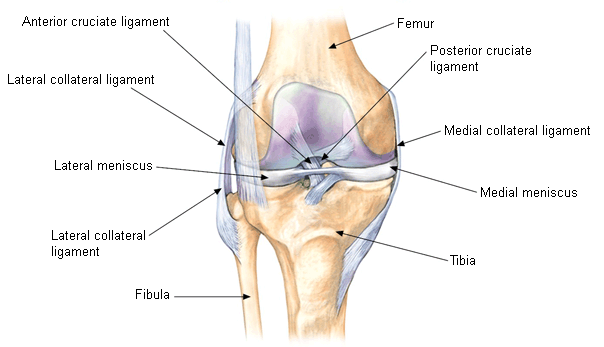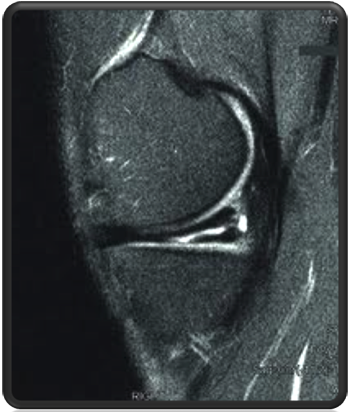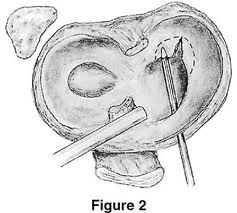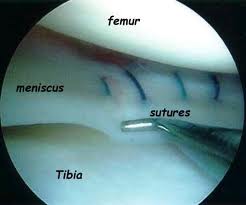Meniscus – Sports Medicine
The most common reason for using arthroscopic surgery in the knee is a torn meniscus (cartilages) in the knee, one medially (inner side) and one laterally (outer side).  The meniscus is a very important structure transmitting 50% of the joint load medially and 70% laterally. It is comprised of fibrocartilage and has a very poor blood supply, its nutrition being received from the joint fluid. Because of this poor blood supply, tears of the meniscus rarely heal on their own and almost always require surgical treatments. The meniscus can tear for a variety of reasons. In the first few decades of life it usually requires a significant trauma to the knee (i.e., sports injury). Past the age of 40 even simple activities such as rising from a chair or stepping awkwardly off a curb can cause a tear. Unfortunately, from a practical standpoint, there is nothing one can do to prevent a meniscus from tearing. Once torn, the meniscus will usually cause pain in the back part of the knee. This is occasionally associated with swelling and the pain can be worsened with flexion. The symptoms are sometimes intermittent or seen only with high levels of activity.
The meniscus is a very important structure transmitting 50% of the joint load medially and 70% laterally. It is comprised of fibrocartilage and has a very poor blood supply, its nutrition being received from the joint fluid. Because of this poor blood supply, tears of the meniscus rarely heal on their own and almost always require surgical treatments. The meniscus can tear for a variety of reasons. In the first few decades of life it usually requires a significant trauma to the knee (i.e., sports injury). Past the age of 40 even simple activities such as rising from a chair or stepping awkwardly off a curb can cause a tear. Unfortunately, from a practical standpoint, there is nothing one can do to prevent a meniscus from tearing. Once torn, the meniscus will usually cause pain in the back part of the knee. This is occasionally associated with swelling and the pain can be worsened with flexion. The symptoms are sometimes intermittent or seen only with high levels of activity.  The diagnosis can be made with a clinical examination and if necessary confirmed with an MRI scan, which is approximately 95% accurate for detecting meniscal tears. Because the meniscus does not heal, the damaged portion needs to be removed. The smaller the tear present the less amount of tissue needs to be removed and conversely, with a larger tear, more meniscal tissue must be removed. Obviously, because it is an important transmitter of stress in the joint, it is advantageous to treat a meniscus tear when it is small so that less tissue has to be removed. Certain tears that occur where the meniscus connects to the joint can be repaired by sewing. These tears usually involve the entire meniscus and occur in younger individuals. Removal of the entire meniscus in these large tears predisposes one to significant arthritis, therefore preservation of the meniscus is extremely important. Because the meniscus has no real blood supply we rely on the blood supply of the neighboring tissues to grow into the tear and heal it. Accordingly, the tear must be less than 5mm or closer to the joint lining for any meniscal tear to predictably heal. Special instrumentation is required for meniscal suturing. Large needles with sutures are passed up through the joints and exit the skin on the side of the meniscus that is being repaired in order to retrieve the sutures.
The diagnosis can be made with a clinical examination and if necessary confirmed with an MRI scan, which is approximately 95% accurate for detecting meniscal tears. Because the meniscus does not heal, the damaged portion needs to be removed. The smaller the tear present the less amount of tissue needs to be removed and conversely, with a larger tear, more meniscal tissue must be removed. Obviously, because it is an important transmitter of stress in the joint, it is advantageous to treat a meniscus tear when it is small so that less tissue has to be removed. Certain tears that occur where the meniscus connects to the joint can be repaired by sewing. These tears usually involve the entire meniscus and occur in younger individuals. Removal of the entire meniscus in these large tears predisposes one to significant arthritis, therefore preservation of the meniscus is extremely important. Because the meniscus has no real blood supply we rely on the blood supply of the neighboring tissues to grow into the tear and heal it. Accordingly, the tear must be less than 5mm or closer to the joint lining for any meniscal tear to predictably heal. Special instrumentation is required for meniscal suturing. Large needles with sutures are passed up through the joints and exit the skin on the side of the meniscus that is being repaired in order to retrieve the sutures.  An incision is necessary to prevent injury to the saphenous nerve, which gives sensation to the inner leg and ankle. For lateral suturing an incision is also used because there is a risk of injury to the peroneal nerve (which allows you to raise your foot and the popliteal artery up and down, which is the main artery behind the knee). “For all adolescents and young adults I feel that all attempts should be made to repair the meniscus rather than removing it and possibly preventing future arthritis.” Says Dr. Mead. The most mechanically sound suture configuration is a vertical suture that is placed by hand. Usually 6 to 16 sutures are placed depending on the tear size. Commercial devices have been developed, but none have achieved the same degree of mechanical strength as a suture placed by hand. All of them, in fact, have been shown to be inferior to suturing by hand.
An incision is necessary to prevent injury to the saphenous nerve, which gives sensation to the inner leg and ankle. For lateral suturing an incision is also used because there is a risk of injury to the peroneal nerve (which allows you to raise your foot and the popliteal artery up and down, which is the main artery behind the knee). “For all adolescents and young adults I feel that all attempts should be made to repair the meniscus rather than removing it and possibly preventing future arthritis.” Says Dr. Mead. The most mechanically sound suture configuration is a vertical suture that is placed by hand. Usually 6 to 16 sutures are placed depending on the tear size. Commercial devices have been developed, but none have achieved the same degree of mechanical strength as a suture placed by hand. All of them, in fact, have been shown to be inferior to suturing by hand.  Several of these devices are associated with joint damage. Unfortunately, great skill and patience is required to successfully sew a meniscus and for this reason it is surely preferred. My policy is to sew all tears that meet appropriate requirements. If a meniscal tear doesn’t heal after suturing, the torn portion can be removed at a later date if it causes symptoms.
Several of these devices are associated with joint damage. Unfortunately, great skill and patience is required to successfully sew a meniscus and for this reason it is surely preferred. My policy is to sew all tears that meet appropriate requirements. If a meniscal tear doesn’t heal after suturing, the torn portion can be removed at a later date if it causes symptoms.

